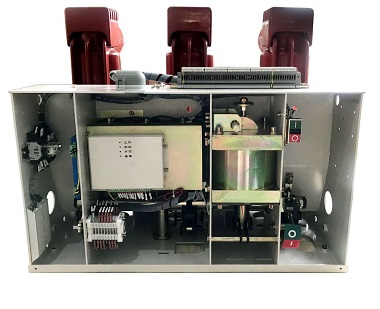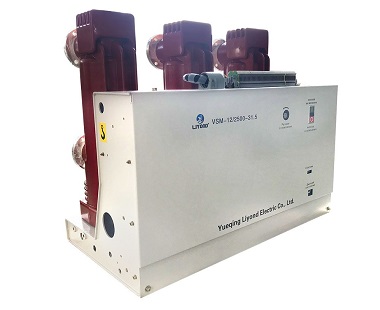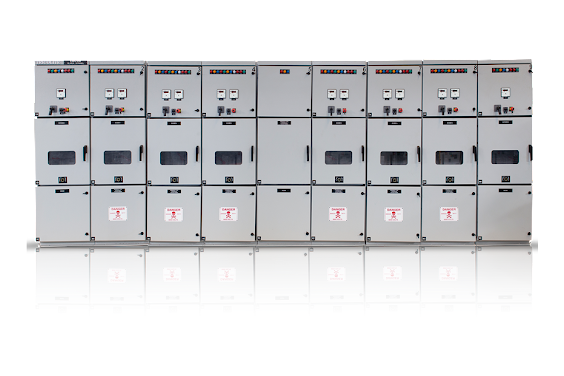Home » What is a Vacuum Circuit Breaker?
During the year 1960, the vacuum interrupter technique was first developed. However, it is still an advancing technology. Due to several technological advancements in this engineering sector, the size of the vacuum interrupter has decreased over time from its early 1960s size.
An industrial circuit breaker is a gadget that interrupts an electrical connection to prevent unintended current from flowing as a result of an open circuit, which is most often produced by an overload. Its primary purpose is to stop current flow when a defect is identified.
VCB is the abbreviation for Vacuum Circuit Breaker. The vacuum is employed as the arc quenching medium in vacuum circuit breakers. A vacuum has the best dielectric strength. As a result, it outperforms all other mediums in terms of arc quenching.
When a circuit breaker’s connections are opened in a vacuum, for example, the disruption happens at the first current zero, with electrical insulation between the contacts rising up at a pace hundreds of times faster than with other sorts of circuit breakers.
The technique is primarily intended for use in medium-voltage switchgear, and vacuum technology for greater voltages has been established.
An HV circuit breaker is made up of a vacuum isolator, a static contact, a moveable contact, and an arc guard. Glass makes up the outer insulated body, which has a high vacuum capacity. The bellows are attached to the moveable part.
By blocking metallic vapors from landing on the inside wall of the outer insulating body, the arc barrier avoids the internal dielectric strength from deteriorating. This enables the chopping energy to be reduced to 3.5 amperes. The strong encapsulation of the chamber is done to completely reduce leaking.

High voltage breaker offers two distinct characteristics:

The vacuum circuit breaker working is explained in detail below with the working of every part.
The metal bellows within the chamber are moved higher and lower during shutting and reopening operations, respectively, by the lower part of the breaker being fixed to a spring-operated or solenoid-operated system. A bounce should be avoided by the contact movement. It’s worth noting that the operating system should apply enough pressure to ensure a secure network between the touchpoints.
Due to the ionization of molecules in the media in between connections all through the circuit breaker contact detachment, an arc is created. The vacuum circuit breaker is designed by HV circuit breaker manufacturers to remove the vacuum between both contacts. Vacuum is defined as any medium with a pressure lower than the atmosphere, which is 760 mm Hg.
Torr is a unit of measurement for low pressures, with 1 torr equaling 1 mm of Hg. A high vacuum is defined as a pressure of less than 10–5 torr.
The pressure gradient in vacuum interrupters affects the dielectric strength of specific contact gaps.
If an arc is to be generated in the vacuum, the tension must be minimal, because only then will it resemble the optimal arc. After it is started, through its burning duration, and when it is extinguished, the ideal arc must have low pressure.
Because it is created by neutral atoms, charges, and electrons discharged by the electrodes directly, the arc generated in the vacuum is distinctive from those generated in other media. The cathode plate is not always entirely smooth, and there are several micro-projections. Because these micro-projections are the last places of engagement during contact dissociation, the current will be centered in them.
Due to their limited cross-sectional area, the projections will experience catastrophic evaporation from thermal conduction and provide enough vapor for the arc to generate in the draw out circuit breaker.
The emission of electrons in a cold cathode could be caused by any of the following mechanisms:
When high currents are used, the ionized metallic vapor distributes out across a vast area around the electrodes in the high voltage vacuum circuit breaker. The amount of vapor generated is substantially reduced at low currents. The chance of retaining a charge carrier frequency sufficient to maintain appropriate resistivity in the column and maintain the emission process decreases when the vapor produced from the cathode areas expands rapidly in the vacuum. The cathode dots disappear in the range of 10–8 seconds at current zero.
The current in a 50 Hz AC indoor vacuum circuit breaker travels across zero value 100 times per second (i.e., once every 10 ms). Because current chopping causes overvoltage, it is preferable to disrupt the current while it is going through a zero value. As a result, for effective arc interruption, the arc must be steady for half a cycle and, more importantly, remain that way at currents approaching zero.
The stability of the arc is shown to be dependent on:
In low-current circuits produced by a VCB manufacturer, the majority of evaporation occurs at distinct sites known as cathode areas, but at higher currents, evaporation occurs from both cathode and anode areas. In addition to these factors, when gas is stripped from other sections of the confinement due to high temperatures and infringing metal vapor, gas is supplied to the contacts’ enclosure.
The higher the vapor pressure at a lower temperature, the stronger the arc’s stability, and thus the lengthier the arc’s life. Some metals, such as Zinc and Bismuth, have such properties and are therefore preferable electrode choices for vacuum circuit breakers. Aside from the vapor pressure, the metal’s thermal resistance has an impact on the current level of chopping.
A good heat-transmitting metal will cool quickly, and the temperature of its contact area will drop. The evaporation rate will be slowed, and the arc will be chopped due to a lack of vapor. A poor heat conductor, on the other hand, will keep its temperature and vaporization for a prolonged duration, and the arc produced by the vacuum circuit breaker working principle
will be more steady.
Diverting the contacts with varied capacitance values diminishes the arc’s usual life length. The lower the average life duration of the arc, the higher the capacitance value. Inductance in series, on the other hand, extends the arc’s duration. Similarly, the longer the arc lasts, the larger the system operating voltage is. This is due to the fact that there is more restorative voltage available to keep the arc going.
Air, oil, paper, and porcelain are the most common insulating materials. These can withstand a significant amount of voltage, but only a fraction of the tolerate voltage of separation in the vacuum.
The benign atoms, ions, and electrons in a vacuum arc are acquired by evaporating the electrodes’ surface material rather than from the media in which the arc is produced. The insulating strength of the vacuum is a hundred times greater than that of the gas when used for arc disruption due to the huge mean free route for electrons.
The dielectric strength of a high vacuum is exceptionally high and vacuum circuit breaker manufacturers make use of this advantageous property. The cathode spot deactivates after 10–8 seconds at current zero, and the previous dielectric strength is quickly restored. The vaporized metal, which is concentrated between the connections, diffuses rapidly due to the absence of gas molecules, resulting in a rapid recovery of high dielectric power. Metallic molecules are driven at high speeds against the glass walls, where they condense.
For an arc current of 100 Ampere, the recuperation intensity during the first few microseconds is 1 kV/s, compared to 50 V/s in the event of an air gap.
Vacuum breakers can be used without restriction for clearing the fault in any position on a system due to the characteristics of vacuum interrupters. They have no trouble dealing with the intense recovery transients associated with short line faults or faults near a transformer. Load switching can be done in a variety of ways with the same convenience.
Due to the instability of the arc column, current chopping in vacuum circuit breakers occurs more frequently than in oil circuit breakers or in air. Current chopping in vacuum circuit breakers is primarily determined by vapor pressure and electrical discharge parameters in the contact material. As a result, the heat conductivity influences the level of chopping; when the heat transfer is low, the chopping level is low.
It is possible to reduce the current level upon which chopping happens by choosing a contacting material that provides enough metal vapor to allow the current to reach a relatively low value; however, this is rarely done because it has a negative impact on the insulating power.
A vacuum circuit breaker is one that uses a vacuum to quench the arc in a circuit breaker. Because of its aesthetic features, the vacuum enhanced arc has a strong insulation power. The majority of these can be used in normal voltage applications. Despite the fact that it is not commercially viable, this technology was created specifically for high-voltage applications.
Within the vacuum chamber of the breaker, the current-carrying conductor and its accompanying arc interruption are regulated. A vacuum interrupter is what it’s called. In the heart of this resistively symmetric ceramic insulator lies a metal arc chamber.

For medium voltage circuit breaker switchgear, the vacuum circuit breaker is now widely regarded as one of the most dependable current interruption devices. In comparison to certain other circuit breaker technology, it requires very little maintenance.
The technique is primarily intended for medium-voltage purposes. Vacuum technology for greater voltages has been devised, however, it is not commercially viable. Metal-clad switchgear and porcelain-encased circuit breakers both use vacuum circuit breakers.
Because VCB can disrupt at very extreme DI/DT-DV/DT circumstances and once a high-frequency current is spatially separated on the DC current, it can readily interrupt a DC current, it is deemed suited for a DC current disruption.
As a result, the DC circuit breaker can be designed in a very compact size because the vacuum interrupter is easy to work in higher-frequency settings.
Vacuum interrupters have a distinct arc interruption method than most types of circuit breakers. Because the vacuum is a dielectric media, no arc can exist in a perfect vacuum.
Detachment of current-carrying connections, on the other hand, causes the vapor to escape from the connections, resulting in plasma. As a result of the separation of current-carrying connections, the contact gap is filled with positive ion vapor released from the contact media, with the volume of the vapor varying based on the current in the arcing. The frequency of vapor release declines during the declining mode of the current wave, and then after the current zero, the media regains its physical properties, provided the vapor density near the contacts has significantly decreased.
The arc normally has multiple parallel courses and each arc route starts and falls in a hot patch of current while breaking a current on the order of a few 100 amperes by splitting the flat contacts under a high vacuum. As a result, the total current is split into multiple parallel arcs. Because the parallel arcs oppose each other, the arc spreads out over the contact surface. The diffused arc is a type of arc like this. The dispersed arc is easily interrupted.
Higher currents, on the order of a few hundred amperes, compress the arc into a narrow area and it becomes a self-sustained arc. The focused arc around a tiny area causes the touch surface to vaporize quickly. The material and geometry of the connection, the current value, and the state of the electrodes all play a role in the transformation from dispersed to focused arc. When the vapor density varies in sync with the current and the arc stays dispersed, the arc can be interrupted. If the metal vapor is immediately withdrawn from the contact zone, the arc does not re-ignite.
Thus, the substance and geometry of the connections, as well as the method of condensing the metallic vapor, play a large role in the arc-extinction process in a vacuum circuit breaker. The contact shape is such that the arc root continues to move, preventing the temperature at one place on the interface from exceeding a certain threshold.
A vacuum circuit breaker’s distinctive benefit is the rapid build-up of dielectric strength after the final arc has been extinguished. Oil circuit breakers have restrictions when transitioning capacitive currents.
After an interruption, the resistance value in oil circuit breakers accumulates so slowly that delayed restrikes can occur up to half a cycle later. The vacuum switch is devoid of this problem since it has a dielectric strength of the order of 100 kV after half a cycle, which corresponds to 2.5 mm contact spacing. This sort of switch has the benefit of being restrike-free and is suitable for capacitor switching.
Vacuum is the most effective insulator. As a result, it outperforms all other mediums in terms of arc quenching. Some of the advantages of using a vacuum circuit breaker include:
So, this blog explains in-depth the VCB working, and vacuum circuit breaker operation. We hope you’ve gained a better understanding of the vcb breaker working principle, its advantages, vacuum circuit breaker applications, and disadvantages. You can reach out to a reliable breaker manufacturer to be assured that you receive high-quality vacuum circuit breakers.
Equip your business with long-lasting switchgear components that respond to your needs and smoothen electrical operations at affordable costs.
Supported File : JPG, AI, PNG, PDF, CAD, JPEG